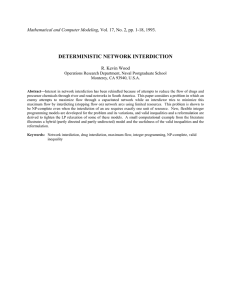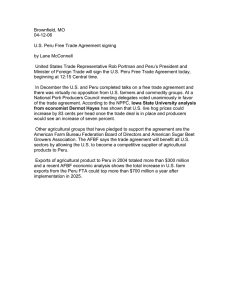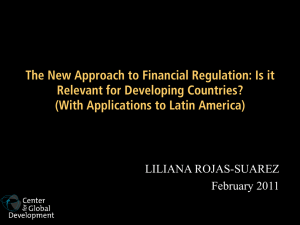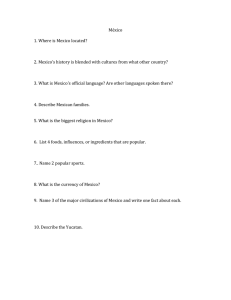Testimony
advertisement
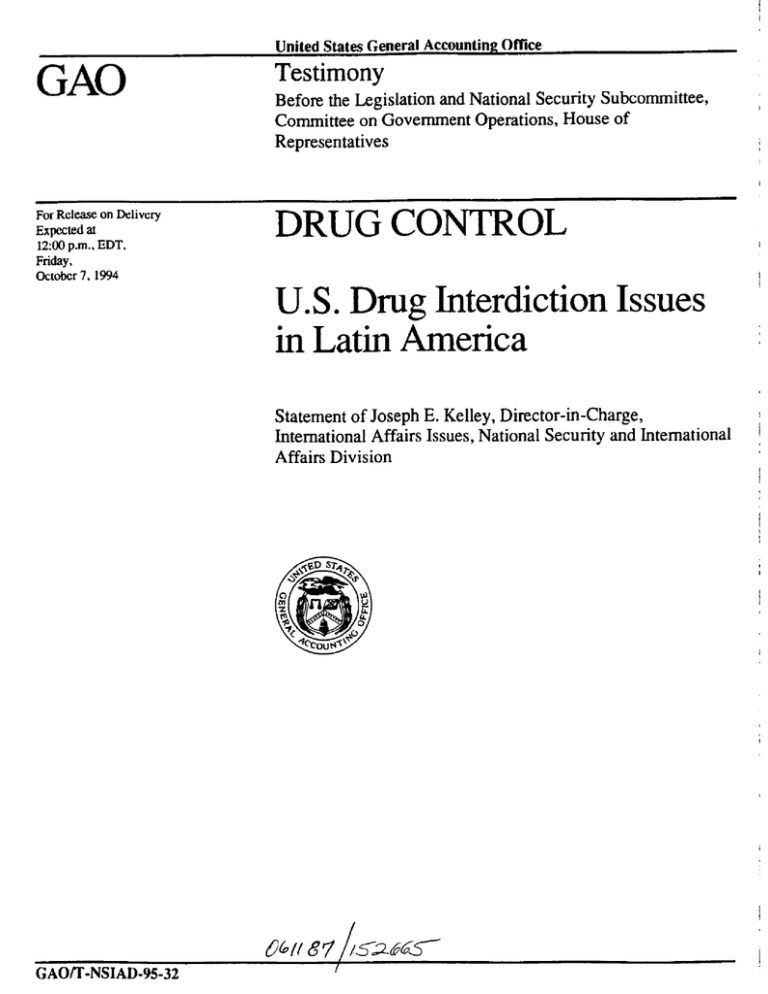
United States General Accounting Office Testimony Before the Legislation and National Security Subcommittee, Committee on Government Operations, House of Representatives For Releaseon Jklivwy Expected at 1200 p.m., EDT. Friday, october 7,1994 DRUG CONTROL U.S. Drug Interdiction Issues in Latin America Statementof JosephE. Kelley, Director-in-Charge, International Affairs Issues,National Security and International Affairs Division GAO/T-NSIAD-95-32 / i i ? Mr. Chairman and Members of the Subcommittee: I am pleased to be here today to discuss the results of our review of the impact in Peru of the U.S. decision in May 1994 to stop sharing real-time detection and monitoring information with certain countries that could be used in shooting down civilian aircraft suspected of transporting illegal drugs.’ In addition, I will have some remarks about our past reviews of drug interdiction.* Our review of various other issues relating to U.S. antidrug efforts in Peru’s Upper Huallaga Valley, undertaken at your request, will be completed in the near future. BACKGROUND Peru grows over 60 percent of the world’s coca crop that is used by the Colombian cartels in the making of cocaine. U.S. officials estimate that almost 90 percent of the drug trafficking activity that takes place between Peru and Colombia occurs by air. These aircraft carry cocaine base from Peru to Colombia for final processing into cocaine and ultimate distribution into the United States and elsewhere. Peruvian forces in the past have used weapons against aircraft suspected of transporting drugs and in early 1994, Colombia announced that it was planning to implement a policy to shoot down drug traffickers. U.S. government officials became concerned that such a policy would violate international law. According to the Justice Department, U.S. officials who knowingly provide information that leads to the shooting down of civilian aircraft could be subject to criminal prosecution. Subsequently, on May 1, 1994, the Defense Department halted the sharing of real-time aircraft tracking information to Colombia and Peru. Later on May 26, 1994, the ‘Drug Control In Peru (GAO/NSIAD-94-186R, Aug. 16, 1994). 2Druq Control: Interdiction Efforts in Central America Have Had Little lmoact on the Flow of Drugs (GAWNSIAD-94-233, Aug. 2, 1994); Drug Control: Heavv Investment in Military Surveillance Is Not Payina Off (GAOINSIAD-93-220, Sept. 1, 1993); and Drug Control: Revised Drug Interdiction Approach Is Needed in Mexico (GAO/NSlAD-93-152, May 10, 1993). 1 Justice Department advised all relevant agencies that assistance programs directly or materially supportive of shootdowns should be suspended pending the completion of a thorough review of the legal questions. In the meantime, the Congress is considering section 1012 of the Fiscal Year 1995 Department of Defense Authorization Act that would provide official immunity for authorized U.S. employees and agents engaged in assisting foreign countries in interdicting aircraft used in illicit drug trafficking. IMPACT OF SHOOTDOWN POLICY ON DRUG-TRAFFICKING ACTIVITIES The policy’s full impact on the flow of drugs from Peru into Colombia is unclear at this time. Information from U.S. reports and Peruvian officials state that this policy has had an adverse impact on the United States’ and Peru’s ability to disrupt drug-trafficking activities because the sharing of realtime information has been suspended and ground based radar in Peru has been shut down. However, indicators of drug-trafficking activities which could be affected by the policy, such as the number of illegal drug flights being detected and the amount of cocaine base being shipped from Peru to Colombia, are inconclusive. Although the initial comparison of these indicators between May and June showed a dramatic increase in drugtrafficking activity, information over a five month period of May through September 1994 show that these indicators fluctuate with no clear pattern being established. What seems clear, however, is that pilots flying between Peru and Colombia have changed their operations since there is little fear of interception by U.S. and Peruvian forces as long as detection capabilities remain negligible and there is no sharing of information. Various U.S. reports and officials have stated that, before the May decision, drug traffickers wanted to minimize their exposure to the air interdiction threat. Thus they (1) used fewer flights with larger drug loads, (2) flew mainly in the early evening hours, and (3) spent on an average only about 10 to 12 minutes in loading and unloading their cargoes. U.S. officials in Peru said that, since the policy change, drug traffickers have changed their operation and (1) have begun multiple flights with smaller drug loads, (2) have begun flying during the day, and (3) some traffickers have doubled their time on the ground. In addition, U.S. officials stated that an analysis of flight patterns indicates that traffickers are reverting to more direct air routes 2 from Peru into Colombia rather than the indirect and more time-consuming routes they were taking before the cutoff of information. Subsequent to our interim report, DEA officials have advised us that the policy to not share realtime information has caused them to forgo law enforcement operations against illegal drug activities that were occurring. Finally, a recent Defense Department report states that the policy of not sharing real-time information has reduced the costs and risks associated with drug trafficking activities in Peru. QTHER GAO REPORTS ADDRESSING INTERDiCTION Mr. Chairman, you requested that we be prepared to testify on other work we have done on U.S. interdiction initiatives. We have issued two reports on various U.S. interdiction efforts in Central America, and Mexico, and we have also examined the Defense Department’s detection and monitoring efforts. In the Central America and Mexico reviews we found that drug traffickers are quick to adapt to law enforcement efforts by changing their routes and modes of operation to elude interdiction. In Guatemala, for example, U.S. antidrug programs that focused on air interdiction were successful in interdicting drug shipments and apprehending drug traffickers. However, within a short time, traffickers changed their methods of operation by using other means of transportation--such as trucks or boats--to elude law enforcement operations. Our review of the Defense Department’s detection and monitoring programs concluded that these costly efforts have limited benefits in helping the U.S. government to interdict drug shipments at a level that would begin to make a difference. Mr. Chairman, despite the problems that I have discussed here today, we believe that some level of interdiction is needed to demonstrate the United States’ resolve against illegal drug trafficking activities. This concludes my testimony. I will be happy to answer any questions you or the Subcommittee may have. (711108) Ordering Information The first copy of each GAO report and testimony is free. Additional copies are $2 each. Orders shouid be sent to the following address, accompanied by a check or money order made out to the Superintendent of Documents, when necessary. Orders for 100 or more copies to be mailed to a single address are discounted 25 percent. Orders by mail: U.S. General Accounting Office P.O. Box 6016 Gaitbersburg, MD 20884-6015 or visit: Room 1100 700 4th St. NW (comer of 4th and G Sts. NW) U.S. General Accounting Office Washington, DC Orders may also be placed by tailing (202) or by using fax number (301) 2584066. 612-6000 Each day, GAO issues a list of newly available reports and testimony. To receive facsimile copies of the daily list or any list fkom the past 30 days, please caiI (301) 2584097 using a touchtone phone. A recorded menu wili provide information on how to obtain these lists. PRINTED ON 44 RECYCLED PAPER United States General Accounting Office Washington, D.C. 20548-0001 Ofl’icial Penalty Business for Private Use $300 Address Correction Reauested BUlkMail Postage & Fees Paid GAO Permit No. GlOO
